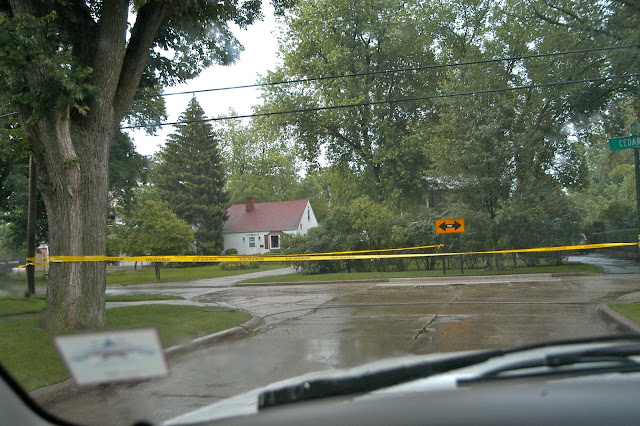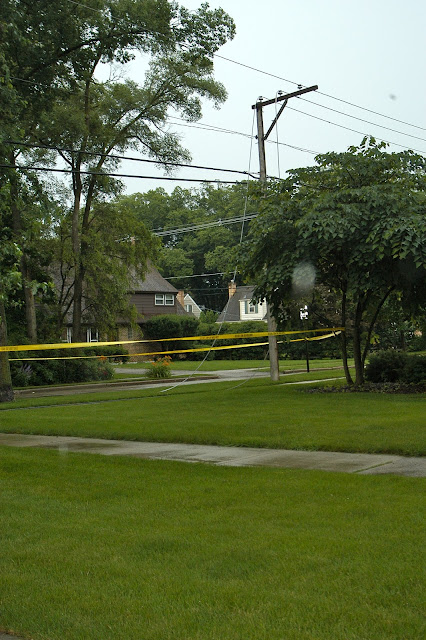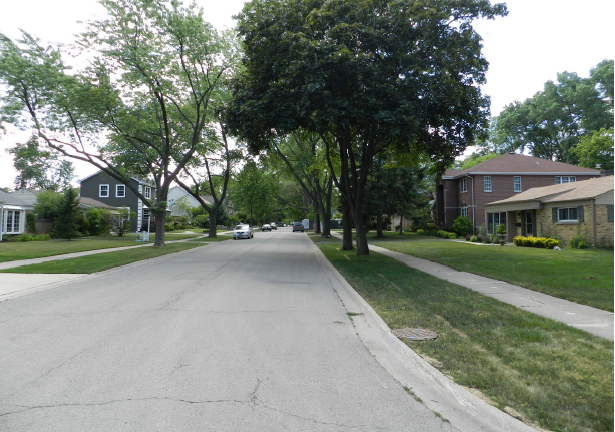Here's the response we received with answers from the ERA consultants in red. ERA is the company that does the maps and gives a thumbs up or down for improvements to our infrastructure. See if you think these replies sound like "We're the government and we're here to help." Or just more B.S. wrapped in jargon.
Dear [Village of Northbrook],
The maps included in the H & H report show extensive street flooding on Westcott and Maple, where arguably NONE exists.
Where is the information for these maps coming from? The information for the surface elevations was obtained through the Village’s Geospatial Information System (GIS) which provides elevation information at one foot intervals. Contour mapping is generally considered accurate to within one half of the contour interval, so, in this case, vertical accuracy of the GIS should be plus or minus six inches. This area is relatively flat so there still may be some deviations in the field that are within the six inch tolerance. The storm sewer routing information was obtained from the Village’s utility atlas information.
There certainly wasn't flooding on Westcott or Maple during this last storm. While we were inundated on Oak. Far more than indicated on your map. And during the July 2010 storm, I had water up to my house from the street. As did several other homes. First, the storm model shows that the flooding in the area of Wescott and Maple occurs prior to the flooding in the 2400 block of Oak Avenue. It also subsides sooner. Therefore, it could have been that, once the flooding in the 2400 block of Oak Avenue was observed, the flooding at Wescott and Maple had already subsided.
The representastion of street flooding in the 2400 block of Oak Avenue should be well past the sidewalks on both sides of the street and more extensive from east to west. The limits of the extent of flooding may be somewhat different based upon the GIS one foot contour mapping.
Secondly, there is NO representation of the overwhelming backyard flooding we get on the 2400 block of Oak Avenue like there seems to be in the 2500 block. There is NOTHING ON THE MAP. Following the storm, we ran a computer model using the same information that was used for the information in the report, but updated to include hydrologic conditions observed during the recent storm. The output from this model depicts the backyard flooding in the 2400 block and seems to provide an good representation of the conditions that were reported during and after the recent storm event.
Oak Avenue Resident asks: So the previous flood maps are wrong and you're going to correct them?
We have proof with video and photographs. And I guarantee it's more than anything in the 2500 block, which is on higher ground.
Has there been a mistake? As discussed in the responses above, using the base information provided from the GIS system and utility atlases, when hydrologic information from the most recent storm is put into the computer modeling, it seems to provide a fairly accurate representation of the conditions reported. The model could be updated with more accurate topographic survey information but we don’t believe it would substantially change the results.
What proof do you have that there really is flooding in the backyards of the 2500 block of Oak on the north side? Or that there is actually street flooding on the 2500 block of Maple? We have seen none.
The backyard flooding shown on the map actually looks more like the 2400 block of Oak than the 2500 block. According to the GIS contour information, a significant amount of flow from the rear yards in the 2400 block of Oak Avenue runs onto Oak Avenue about three houses west of Western. If this flow area is restricted by obstructions in side yard ditches or swales it likely makes it more difficult for the water to drain out. These conditions could cause additional backyard flooding in the rear yards of the 2400 block than what is shown in the report. A detailed topographic survey of the side and rear yards in this area would be necessary to verify this condition.
Oak Avenue Resident suggests, once again: Get your butts out in the field.
And whaddya mean the "significant flow" occurs "about three houses west of Western?" It occurs in the backyards of the third, fourth, fifth, and sixth houses west of Western. But you wouldn't know that, because you don't get out in the field.
Even more egregious, to suggest that "obstructions" in the backyards on Oak Avenue are the reasons for the sudden enormous backyard flooding is another example of Village incompetence. As if the huge footprints and elevated grades allowed for the new construction on Maple Avenue had nothing to do with the oceans of displaced water that suddenly had nowhere to go, but down hill.
Can you explain how the alleged "obstructions" blocking the flow from the Oak Avenue yards occurred at the same time? To all those yards? Did we mention that the flooding was rIght after the mega-homes went up on Maple Avenue?
Oak Avenue Resident suggests, once again: Get your butts out in the field.
And whaddya mean the "significant flow" occurs "about three houses west of Western?" It occurs in the backyards of the third, fourth, fifth, and sixth houses west of Western. But you wouldn't know that, because you don't get out in the field.
Even more egregious, to suggest that "obstructions" in the backyards on Oak Avenue are the reasons for the sudden enormous backyard flooding is another example of Village incompetence. As if the huge footprints and elevated grades allowed for the new construction on Maple Avenue had nothing to do with the oceans of displaced water that suddenly had nowhere to go, but down hill.
Can you explain how the alleged "obstructions" blocking the flow from the Oak Avenue yards occurred at the same time? To all those yards? Did we mention that the flooding was rIght after the mega-homes went up on Maple Avenue?
But then, what more can we expect, when no one from the Village bothers to come out to the field?
Can you offer some way of proving that these maps are accurate, please? Hopefully, the explanations provided above are helpful in providing a better understanding of the accuracy and to some degree the limitations of the information shown on the maps.
Oak Avenue Resident replies to ERA Consultant: Short answer? No.
It's pretty clear none of the ERA people have been out to the 2400 block of Oak Avenue, EVER.
































